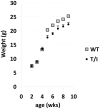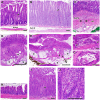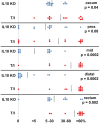A novel murine model of inflammatory bowel disease and inflammation-associated colon cancer with ulcerative colitis-like features
- PMID: 22848611
- PMCID: PMC3407062
- DOI: 10.1371/journal.pone.0041797
A novel murine model of inflammatory bowel disease and inflammation-associated colon cancer with ulcerative colitis-like features
Abstract
Mutations that increase susceptibility to inflammatory bowel disease (IBD) have been identified in a number of genes in both humans and mice, but the factors that govern how these mutations contribute to IBD pathogenesis and result in phenotypic presentation as ulcerative colitis (UC) or Crohn disease (CD) are not well understood. In this study, mice deficient in both TNF and IL-10 (T/I mice) were found to spontaneously develop severe colitis soon after weaning, without the need for exogenous triggers. Colitis in T/I mice had clinical and histologic features similar to human UC, including a markedly increased risk of developing inflammation-associated colon cancer. Importantly, development of spontaneous colitis in these mice was prevented by antibiotic treatment. Consistent with the known role of Th17-driven inflammation in response to bacteria, T/I mice had elevated serumTh17-type cytokines when they developed spontaneous colitis and after systemic bacterial challenge via NSAID-induced degradation of the mucosal barrier. Although TNF production has been widely considered to be be pathogenic in IBD, these data indicate that the ability to produce normal levels of TNF actually protects against the spontaneous development of colitis in response to intestinal colonization by bacteria. The T/I mouse model will be useful for developing new rationally-based therapies to prevent and/or treat IBD and inflammation-associated colon cancer and may further provide important insights into the pathogenesis of UC in humans.
Conflict of interest statement
Figures





Similar articles
-
MicroRNA214 Is Associated With Progression of Ulcerative Colitis, and Inhibition Reduces Development of Colitis and Colitis-Associated Cancer in Mice.Gastroenterology. 2015 Oct;149(4):981-92.e11. doi: 10.1053/j.gastro.2015.05.057. Epub 2015 Jun 6. Gastroenterology. 2015. PMID: 26055138 Free PMC article.
-
Deficiency of activation-induced cytidine deaminase in a murine model of ulcerative colitis.PLoS One. 2020 Sep 17;15(9):e0239295. doi: 10.1371/journal.pone.0239295. eCollection 2020. PLoS One. 2020. PMID: 32941525 Free PMC article.
-
Batf-dependent Th17 cells critically regulate IL-23 driven colitis-associated colon cancer.Gut. 2016 Jul;65(7):1139-50. doi: 10.1136/gutjnl-2014-308227. Epub 2015 Apr 2. Gut. 2016. PMID: 25838550
-
Development, validation and implementation of an in vitro model for the study of metabolic and immune function in normal and inflamed human colonic epithelium.Dan Med J. 2015 Jan;62(1):B4973. Dan Med J. 2015. PMID: 25557335 Review.
-
IL-23 in inflammatory bowel diseases and colon cancer.Cytokine Growth Factor Rev. 2019 Feb;45:1-8. doi: 10.1016/j.cytogfr.2018.12.002. Epub 2018 Dec 12. Cytokine Growth Factor Rev. 2019. PMID: 30563755 Review.
Cited by
-
Cytokine-Induced Modulation of Colorectal Cancer.Front Oncol. 2016 Apr 19;6:96. doi: 10.3389/fonc.2016.00096. eCollection 2016. Front Oncol. 2016. PMID: 27148488 Free PMC article. Review.
-
Inflammatory Cytokine: An Attractive Target for Cancer Treatment.Biomedicines. 2022 Aug 29;10(9):2116. doi: 10.3390/biomedicines10092116. Biomedicines. 2022. PMID: 36140220 Free PMC article. Review.
-
Chronic Model of Inflammatory Bowel Disease in IL-10-/- Transgenic Mice: Evaluation with Ultrasound Molecular Imaging.Theranostics. 2019 Aug 14;9(21):6031-6046. doi: 10.7150/thno.37397. eCollection 2019. Theranostics. 2019. PMID: 31534535 Free PMC article.
-
Molecular mechanism of action of anti-tumor necrosis factor antibodies in inflammatory bowel diseases.World J Gastroenterol. 2016 Nov 14;22(42):9300-9313. doi: 10.3748/wjg.v22.i42.9300. World J Gastroenterol. 2016. PMID: 27895418 Free PMC article. Review.
-
Jianpi Qingchang Decoction Ameliorates Chronic Colitis in Piroxicam-Induced IL-10 Knockout Mice by Inhibiting Endoplasmic Reticulum Stress.Evid Based Complement Alternat Med. 2022 Feb 9;2022:7378807. doi: 10.1155/2022/7378807. eCollection 2022. Evid Based Complement Alternat Med. 2022. PMID: 35186102 Free PMC article.
References
-
- Van der Linde K, Boor PPC, Sandkuijl LA, Meijssen MAC, Savelkoul HFJ, et al. (2003) A Gly15Arg mutation in the interleukin-10 gene reduces secretion of interleukin-10 in Crohn disease. Scand J Gastroenterol 38: 611–617. - PubMed
-
- Franke A, Balschun T, Karlsen TH, Sventoraityte J, Nikolaus S, et al. (2008) Sequence variants in IL10, ARPC2 and multiple other loci contribute to ulcerative colitis susceptibility. Nature Genet. 40: 1319–1323. - PubMed
-
- Mottet C, Uhlig HH, Powrie F (2003) Cutting edge: Cure of colitis by CD4+CD25+ regulatory T cells. J Immunol. 170: 3939–3943. - PubMed
Publication types
MeSH terms
Substances
Grants and funding
LinkOut - more resources
Full Text Sources
Medical
Molecular Biology Databases

